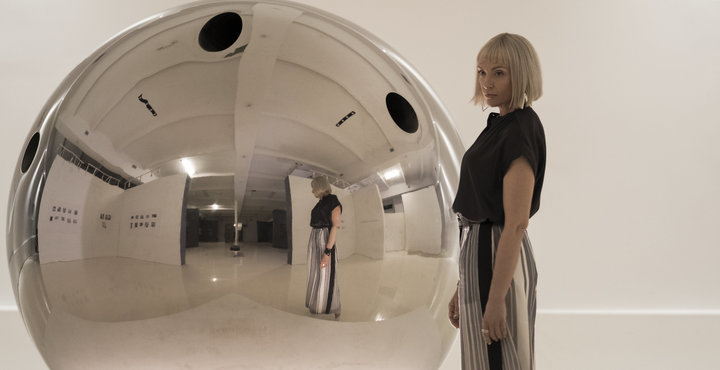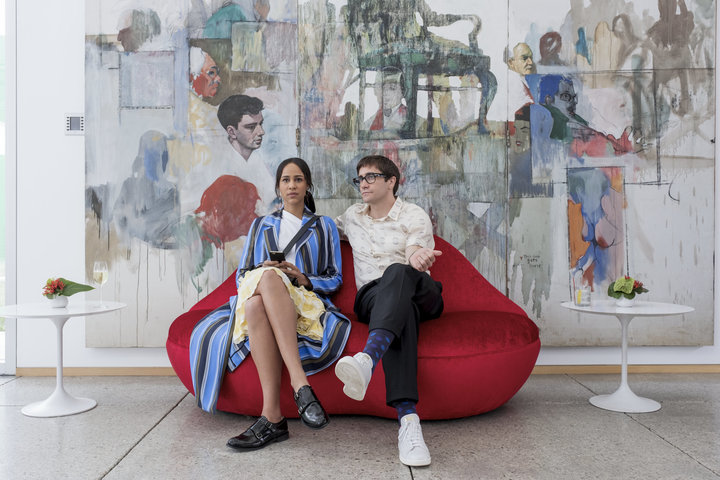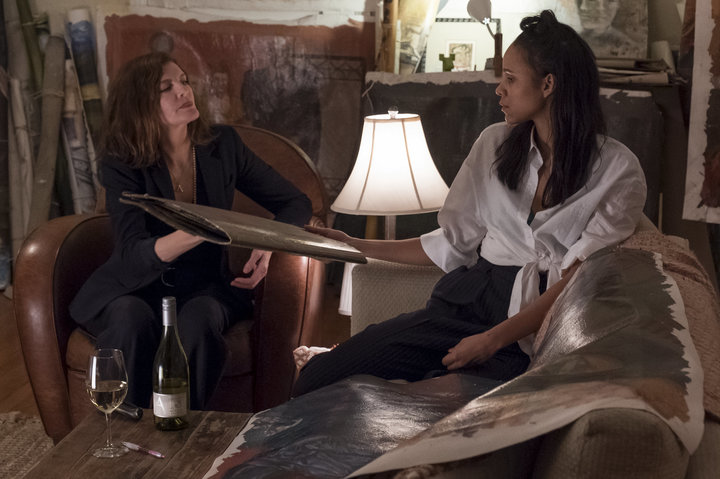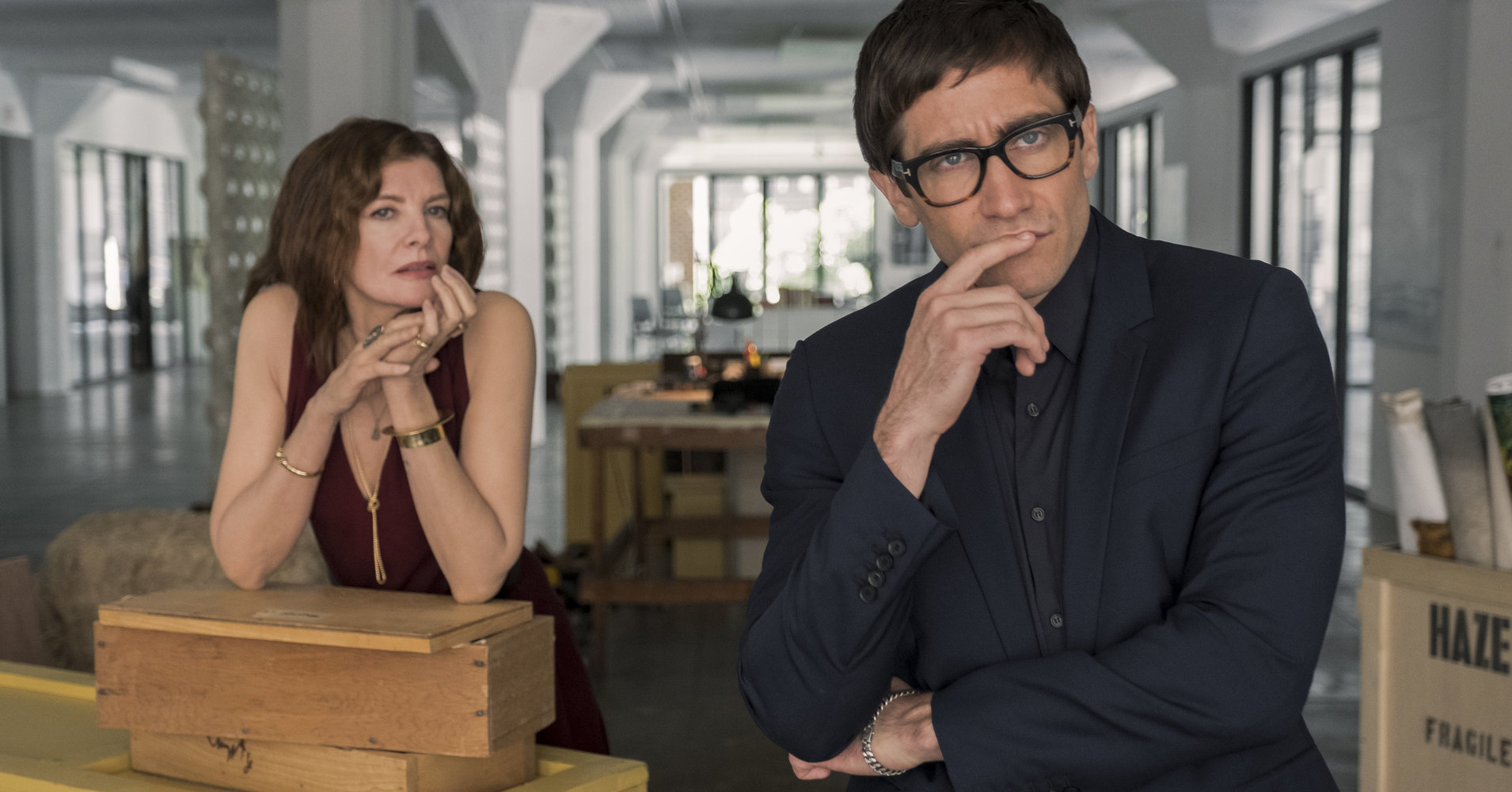[ad_1]
It was the correction heard ’round the world.
Huddled in a studio in the heart of Park City, Utah, the cast of “Velvet Buzzsaw” was perched atop a set of chairs and a couch, working their way through an obligatory press day at the Sundance Film Festival. Tasked with spending hours expounding upon his latest movie, director Dan Gilroy began unleashing a deluge of adjectives to describe his wife and star, Rene Russo.
“She’s soulful, spiritual,” he said, “a touch of melancholy once in a while.”
That’s when the world stopped.
Gilroy pronounced “melancholy” as if it rhymed with “kaplonk-ly”: “me-LAHNK-ly.” Jake Gyllenhaal, who looked as though he’d been bracing himself for the flub, gently interjected. “It’s melancholy, Dan,” Gyllenhaal said, adding, “That is not the first time that’s happened today.”
It was a priceless moment. The kind of “Stars, they’re just like us!” gaffe that cut the noise of a press cycle for just a moment, as self-appointed meme makers scrambled to make the most of Gyllenhaal’s exasperated look.
Except, according to Gilroy, it wasn’t a gaffe at all. It was a bit.
“I hate to burst that bubble,” Gilroy said over the phone, “but we were, in fact, re-enacting ‘Megamind.’”
Yes, “Megamind,” the 2010 animated adventure movie about a supervillain’s identity crisis. “In the movie, Will Ferrell, who plays Megamind, came up with this little schtick where he’s smart but he can’t pronounce a lot of words, and one of those is ‘melancholy,’” Gilroy explained. “Jake and I are always playing around, so like five minutes before that interview, we’re laughing, and I’m using the word ‘me-LAHNK-ly,’ and Jake’s laughing and making it worse.”
When he found himself in front of the cameras, Gilroy said, he decided to just throw the word out there. “Jake sort of riffs on it, and I riffed on it,” he said. And a viral interview moment was born.
Gilroy said he originally didn’t want to ruin the internet’s fun by confessing to the gag, but alas. “I wasn’t going to bring it up, because it’s fun to imagine” he lamented. “But the reality is we were totally fooling around.”
His hesitation to correct our assumptions, not for any reason of embarrassment but for the sake of maintaining an illusion, is in lockstep with his latest movie’s ethos of artifice. “Velvet Buzzsaw” is an absurd and delicious critique of the art world’s outsize self-seriousness. Revolving around bespectacled art critic Morf Vandewalt (Gyllenhaal), fatally chic gallery owner Rhodora Haze (Russo) and crafty dilettante Josephina (Zawe Ashton), it’s a kooky cautionary tale with the morality of an ’80s slasher flick.
The unhinged satirical chaos is punctuated by subtly hilarious interludes: Billy Magnussen rocking AirPods. Daveed Diggs making eggs. Toni Collette terrorizing a pair of museum curators. In context, Gilroy’s “me-LAHNK-ly” bit feels like a deleted “Velvet Buzzsaw” scene, yet another transparent condemnation of a certain kind of self-satisfied intellectual. In an interview with HuffPost ahead of the film’s Netflix release, Gilroy spoke about the dark corners of the art world, wireless headphones and, of course, the name Morf.
As a filmmaker with a past life in film journalism, what was it about the figure of the critic you wanted to explore?
Once you decide to make a movie about the contemporary art world, certain figures pop up, and the critic becomes one of those characters. I used to review films for Variety for years. I was a reporter and a writer, so I know the world of criticism, and it’s a very serious part of what we do. It was something I was exploring with Jake’s character. He’s somebody who, like everybody in the film, is dollar signs, and I think those pressures pervert their work, to a degree. Jake as a critic crosses a line in the film, and he pays for it.
But I’m not saying [this] to condemn critics. I think, if anything, when an artist tries something new ― and I actually have a specific example in Darren Aronofsky’s “Mother!” ― whether you think it’s good or bad, the guy’s doing something really innovative and new. And I didn’t really see that factored into the equation.

So much of this movie is devoted to exploring the intersection of art and commerce as it relates to the art world, but it’s also true that the film industry is in a similar position. Can you talk a little bit more about what drew you to these themes?
I became very interested in researching the world of contemporary art because contemporary art is a world that really began to provoke. And it got really co-opted by money. It’s an interesting conflict in that world, and I think it was interesting narratively to explore. From a message standpoint, if there is a theme that you could reduce it to, I’m trying to say that art is more than a commodity. That art is literally — that’s a part of their soul and their work, and that needs to be respected. Ultimately, it doesn’t matter if it sells at Sotheby’s for $200 million or it’s got 500 views on YouTube — these things have their own inherent value that we should never forget. That’s sort of what I was drifting to with this.
Every single one of these characters is so vibrant and weird and terrible and watchable. Is anyone based on any real art world figures?
They were amalgams. Because once you know you’re going to have a gallery owner or an artist or a critic, it liberates you to sort of take those characters in any direction you want, and I didn’t need templates. You can imagine a critic, you can imagine a contemporary artist. Certain images start to appear that help you formulate these, so I didn’t need to go to a specific person to formulate any of these characters.
Is there someone or something you think embodies the worst qualities of the art world?
I researched heavily, and there’s no name I’d land upon. But I will say from a factual standpoint, I think 20 artists account for more than half of the billions of billions of sales in the contemporary art world. There’s nothing wrong with that, I’m not judging them, but there are people who are branded artists. Some of them have little factories where they do reproductions and facsimiles, and it’s another revenue stream. Commerce is really deeply embedded in that part of the art world.

I really love that this movie, which is so glossy and high-minded in a lot of ways, is still governed by slasher movie logic. When did you know you were going to be playing with those tropes?
I started to think of pop art, and pop art has got a mash and a collision of different things. There’s a sort of vibrancy to it. And then I started thinking about satire. Satire’s a very powerful way to translate ideas, particularly the ones in this film, so once we started thinking satire and got to the thriller aspect, we just decided to go campy and kitschy with it. I mean, someone walking into a dark room and going, “Here, kitty, kitty,” I mean, how many times have we seen that? Where she wanders in and sets the whole ball rolling. The backstory for our deranged artist ― he was in a mental hospital and he paints with his own blood. It’s almost gothic. To me, it’s fun. That experience liberated us once we realized where we were going with it.
I have to ask about the AirPods ― which, in the hands (or ears) of Billy Magnussen, become possibly the most impactful prop in the movie. I loved that so much.
That’s so funny! That’s so funny. AirPods are such an interesting little thing. They look like earrings. The first time I saw them, I thought they looked like earrings — people walking around looking utterly comfortable and casual, which is great. I just thought it was just an interesting visual to give to Billy Magnussen’s character, that he listens to music through AirPods all the time, and when something happens to him, that’s the only remnant left of his life: these AirPods.
Morf’s sexuality turns out to be pretty crucial to the thrust of this movie ― he’s at first heavily coded as a gay man who then engages in this artistic and sexual affair with an art world ingenue.
Jake plays a very influential contemporary art critic — he takes his art very seriously. And on the sexual spectrum, he’s bisexual, and where that came from, in part, was when I was working on the script, Quincy Jones did an interview in which he discussed Marlon Brando had had a relationship with Richard Pryor. And I thought that was a wonderful thing to know, and I thought it was an underutilized element for a character. I thought it was something that would be interesting for Jake’s character.
His character also has a very specific physicality. Did you speak about formulating that together, or did that just arrive on set?
I never discussed any of the physical aspects of the character with Jake. Jake comes in, and when actors come in ― how they move, what they do ― it becomes a very personal choice for them. I, from the first moment the actor comes on, I’m encouraging them to hone the character and create the character. And we usually get a good result.

I can’t let you go without asking who helped create the art in this movie. You didn’t have the luxury of not showing the work in the film. What was the process of bringing these pieces to life?
It was a big hurdle. There’s two kinds of art in the film, one is the art that Vetril Dease [Alan Mandell] makes, and then there’s the art that exists on the walls of the galleries. For the art that the artist makes in the film, I had gone to our art adviser, David Hundley, about six months before we started shooting, and we started talking about what we needed. So we contacted this Los Angeles artist named Saxon Brice. We spent three, four, five months working with them and our production designer, Jim Bissell, and creating dozens and dozens of pieces. The painting themselves are dark and a little arresting because the artist in the film is continuing to work through a ton of childhood trauma. And they’re representational. They couldn’t be abstract because we had to have the father and the mother and the daughter and the son.
Before you go, I also have to ask about Morf. What a weird and wonderful name.
I want to say it’s a Dutch name. It’s a name I’ve seen before. I have files and files of names. I think I saw Morf Vandewalt on a census roll in the 1800s in the South when I was working on a movie. I can tell you that’s how I got the name Vetril Dease. Morf Vandewalt might have been there as well. That might have been a real person that lived hundreds of years ago, and I just wrote it down.
This interview has been edited and condensed for clarity.
[ad_2]
Source link

